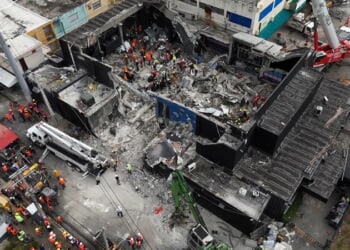As previously reported, Europe is already rethinking its commitment to the Lockheed Martin F-35 Lightning II. At the same time, aerospace giant Boeing may find it hard to find foreign buyers for its sixth-generation F-47, the centerpiece of the United States Air Force‘s Next Generation Air Dominance (NGAD) system of systems.
Some of America‘s closest allies are already exploring other options. Two competing sixth-generation fighter programs are underway, and now one could expand.
Will Australia and Canada Join GCAP?
According to a recent report from aviation trade magazine Flight Global, an official with the Royal Australian Air Force (RAAF) has received an “informational briefing [on] the Global Combat Air Programme (GCAP) consortium—a trilateral initiative between the UK, Italy, and Japan to develop a sixth-generation fighter.”
Originally known as the Tempest in the UK, the program aims to field an aircraft by the mid-2030s, replacing Japan‘s F-2 and the Eurofighter Typhoon used by the UK and Italy. The fighter is expected to feature optional manning, an augmented reality cockpit, “Loyal Wingmen” support, and possibly directed-energy weapons and AI co-pilots.
Last October, Japanese Defense Minister Gen Nakatani, the UK Secretary of State for Defence John Healey, and Italian Defence Minister Guido Crosetto met on the sidelines of the Group of Seven defense minister meeting in Naples. It announced that the GCAP International Government Organization (GIGO) would be set up to oversee the development of the next-generation fighter.
As reported by Flight Global, Australia has expressed interest in joining the effort and could be joined by Canada. Following the Trump administration‘s decision last month to impose a 25 percent tariff on Canadian imports and the president‘s repeated calls to make the neighbor to the north the “fifty-first state,” Canadian Prime Minister Mark Carney launched a review into Ottawa‘s deal with Washington to purchase eighty-eight F-35s.
Ottawa has reportedly explored alternatives, including the French-made Dassault Rafale and the Swedish Saab JAS 39 Gripen. Meanwhile, Canberra has also been reviewing its options, following Washington‘s 25 percent tariffs on steel and aluminum imports from the land down under.
A Common Commonwealth Jet Fighter for the GCAP
Australia and Canada are members of the Commonwealth of Nations (AKA the British Commonwealth) and have deep ties with the UK. They have “Royal” air forces, the RAAF and Royal Canadian Air Force (RCAF), which have operated British-designed/made fighters.
Last month, David Chadwick, a British Liberal Democrat MP for Brecon, Radnor, and Cwm Tawe, called for the UK‘s Ministry of Defence (MoD) to invite Canada to join the GCAP program. UK Defence Minister Maria Eagle responded that the consortium members would be open to Canada‘s cooperation on the program if it would not delay or otherwise impede it.
Army Recognition also reported it signaled “a potential pathway for Canadian involvement, and analysts have noted that Canada may be a suitable candidate due to its membership in the Five Eyes intelligence alliance and strong defense ties with the UK. Additionally, Canada‘s recent procurement of the F-35A aligns its fleet with those of the GCAP nations, all of which operate or plan to operate the same aircraft.”
Australia already operates the F-35A, the conventional takeoff and landing variant of the Joint Strike Fighter, and is a member of the Australia, United Kingdom, United States (AUKUS) consortium with the UK and the U.S.
While it calls for closer ties between the three states, including the development of defense technology, its tier one program, centered on nuclear-powered submarines that all three nations could operate, has been criticized by President Donald Trump in the past.
Given these facts, Australia and Canada could likely become junior partners in the GCAP program.
About the Author: Peter Suciu
Peter Suciu is a Michigan-based writer. He has contributed to more than four dozen magazines, newspapers, and websites with over 3,200 published pieces over a twenty-year career in journalism. He regularly writes about military hardware, firearms history, cybersecurity, politics, and international affairs. Peter is also a Contributing Writer for Forbes and Clearance Jobs. You can follow him on Twitter: @PeterSuciu. You can email the author: [email protected].
Image: Shutterstock/ Mike Mareen.

















